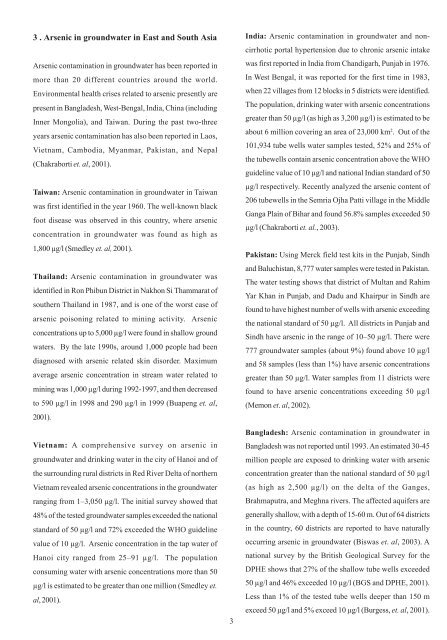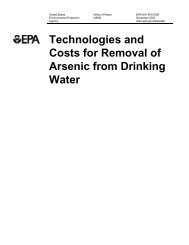The State of Arsenic in Nepal - 2003 - Harvard University ...
The State of Arsenic in Nepal - 2003 - Harvard University ...
The State of Arsenic in Nepal - 2003 - Harvard University ...
Create successful ePaper yourself
Turn your PDF publications into a flip-book with our unique Google optimized e-Paper software.
3 . <strong>Arsenic</strong> <strong>in</strong> groundwater <strong>in</strong> East and South Asia<br />
<strong>Arsenic</strong> contam<strong>in</strong>ation <strong>in</strong> groundwater has been reported <strong>in</strong><br />
more than 20 different countries around the world.<br />
Environmental health crises related to arsenic presently are<br />
present <strong>in</strong> Bangladesh, West-Bengal, India, Ch<strong>in</strong>a (<strong>in</strong>clud<strong>in</strong>g<br />
Inner Mongolia), and Taiwan. Dur<strong>in</strong>g the past two-three<br />
years arsenic contam<strong>in</strong>ation has also been reported <strong>in</strong> Laos,<br />
Vietnam, Cambodia, Myanmar, Pakistan, and <strong>Nepal</strong><br />
(Chakraborti et. al, 2001).<br />
Taiwan: <strong>Arsenic</strong> contam<strong>in</strong>ation <strong>in</strong> groundwater <strong>in</strong> Taiwan<br />
was first identified <strong>in</strong> the year 1960. <strong>The</strong> well-known black<br />
foot disease was observed <strong>in</strong> this country, where arsenic<br />
concentration <strong>in</strong> groundwater was found as high as<br />
1,800 µg/l (Smedley et. al, 2001).<br />
Thailand: <strong>Arsenic</strong> contam<strong>in</strong>ation <strong>in</strong> groundwater was<br />
identified <strong>in</strong> Ron Phibun District <strong>in</strong> Nakhon Si Thammarat <strong>of</strong><br />
southern Thailand <strong>in</strong> 1987, and is one <strong>of</strong> the worst case <strong>of</strong><br />
arsenic poison<strong>in</strong>g related to m<strong>in</strong><strong>in</strong>g activity. <strong>Arsenic</strong><br />
concentrations up to 5,000 µg/l were found <strong>in</strong> shallow ground<br />
waters. By the late 1990s, around 1,000 people had been<br />
diagnosed with arsenic related sk<strong>in</strong> disorder. Maximum<br />
average arsenic concentration <strong>in</strong> stream water related to<br />
m<strong>in</strong><strong>in</strong>g was 1,000 µg/l dur<strong>in</strong>g 1992-1997, and then decreased<br />
to 590 µg/l <strong>in</strong> 1998 and 290 µg/l <strong>in</strong> 1999 (Buapeng et. al,<br />
2001).<br />
Vietnam: A comprehensive survey on arsenic <strong>in</strong><br />
groundwater and dr<strong>in</strong>k<strong>in</strong>g water <strong>in</strong> the city <strong>of</strong> Hanoi and <strong>of</strong><br />
the surround<strong>in</strong>g rural districts <strong>in</strong> Red River Delta <strong>of</strong> northern<br />
Vietnam revealed arsenic concentrations <strong>in</strong> the groundwater<br />
rang<strong>in</strong>g from 1–3,050 µg/l. <strong>The</strong> <strong>in</strong>itial survey showed that<br />
48% <strong>of</strong> the tested groundwater samples exceeded the national<br />
standard <strong>of</strong> 50 µg/l and 72% exceeded the WHO guidel<strong>in</strong>e<br />
value <strong>of</strong> 10 µg/l. <strong>Arsenic</strong> concentration <strong>in</strong> the tap water <strong>of</strong><br />
Hanoi city ranged from 25–91 µg/l. <strong>The</strong> population<br />
consum<strong>in</strong>g water with arsenic concentrations more than 50<br />
µg/l is estimated to be greater than one million (Smedley et.<br />
al, 2001).<br />
3<br />
India: <strong>Arsenic</strong> contam<strong>in</strong>ation <strong>in</strong> groundwater and noncirrhotic<br />
portal hypertension due to chronic arsenic <strong>in</strong>take<br />
was first reported <strong>in</strong> India from Chandigarh, Punjab <strong>in</strong> 1976.<br />
In West Bengal, it was reported for the first time <strong>in</strong> 1983,<br />
when 22 villages from 12 blocks <strong>in</strong> 5 districts were identified.<br />
<strong>The</strong> population, dr<strong>in</strong>k<strong>in</strong>g water with arsenic concentrations<br />
greater than 50 µg/l (as high as 3,200 µg/l) is estimated to be<br />
about 6 million cover<strong>in</strong>g an area <strong>of</strong> 23,000 km 2 . Out <strong>of</strong> the<br />
101,934 tube wells water samples tested, 52% and 25% <strong>of</strong><br />
the tubewells conta<strong>in</strong> arsenic concentration above the WHO<br />
guidel<strong>in</strong>e value <strong>of</strong> 10 µg/l and national Indian standard <strong>of</strong> 50<br />
µg/l respectively. Recently analyzed the arsenic content <strong>of</strong><br />
206 tubewells <strong>in</strong> the Semria Ojha Patti village <strong>in</strong> the Middle<br />
Ganga Pla<strong>in</strong> <strong>of</strong> Bihar and found 56.8% samples exceeded 50<br />
µg/l (Chakraborti et. al., <strong>2003</strong>).<br />
Pakistan: Us<strong>in</strong>g Merck field test kits <strong>in</strong> the Punjab, S<strong>in</strong>dh<br />
and Baluchistan, 8,777 water samples were tested <strong>in</strong> Pakistan.<br />
<strong>The</strong> water test<strong>in</strong>g shows that district <strong>of</strong> Multan and Rahim<br />
Yar Khan <strong>in</strong> Punjab, and Dadu and Khairpur <strong>in</strong> S<strong>in</strong>dh are<br />
found to have highest number <strong>of</strong> wells with arsenic exceed<strong>in</strong>g<br />
the national standard <strong>of</strong> 50 µg/l. All districts <strong>in</strong> Punjab and<br />
S<strong>in</strong>dh have arsenic <strong>in</strong> the range <strong>of</strong> 10–50 µg/l. <strong>The</strong>re were<br />
777 groundwater samples (about 9%) found above 10 µg/l<br />
and 58 samples (less than 1%) have arsenic concentrations<br />
greater than 50 µg/l. Water samples from 11 districts were<br />
found to have arsenic concentrations exceed<strong>in</strong>g 50 µg/l<br />
(Memon et. al, 2002).<br />
Bangladesh: <strong>Arsenic</strong> contam<strong>in</strong>ation <strong>in</strong> groundwater <strong>in</strong><br />
Bangladesh was not reported until 1993. An estimated 30-45<br />
million people are exposed to dr<strong>in</strong>k<strong>in</strong>g water with arsenic<br />
concentration greater than the national standard <strong>of</strong> 50 µg/l<br />
(as high as 2,500 µg/l) on the delta <strong>of</strong> the Ganges,<br />
Brahmaputra, and Meghna rivers. <strong>The</strong> affected aquifers are<br />
generally shallow, with a depth <strong>of</strong> 15-60 m. Out <strong>of</strong> 64 districts<br />
<strong>in</strong> the country, 60 districts are reported to have naturally<br />
occurr<strong>in</strong>g arsenic <strong>in</strong> groundwater (Biswas et. al, <strong>2003</strong>). A<br />
national survey by the British Geological Survey for the<br />
DPHE shows that 27% <strong>of</strong> the shallow tube wells exceeded<br />
50 µg/l and 46% exceeded 10 µg/l (BGS and DPHE, 2001).<br />
Less than 1% <strong>of</strong> the tested tube wells deeper than 150 m<br />
exceed 50 µg/l and 5% exceed 10 µg/l (Burgess, et. al, 2001).

















